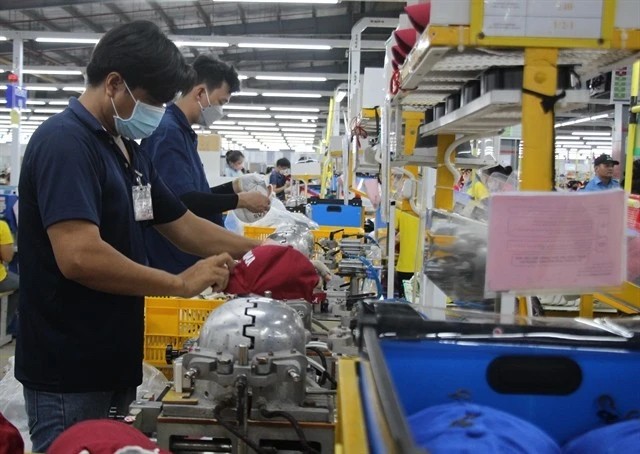Labor productivity and wage growth in Vietnam: Report
Over the past decade, while the labor productivity level of Vietnam remains low compared to other neighboring countries, the dramatic increase of minimum wage and wage has posed a concern over the competitiveness of firms in particular and the country in general, Nguyen Duc Thanh, President of the Vietnam Institute for Economic and Policy Research (VEPR), told a workshop on September 13th in Hanoi.
The report “Labor Productivity and Wage Growth in Vietnam”, released at the workshop, assesses the current labor market legislations with a focus on minimum wage policy in Vietnam, the relationship between growth rates of minimum wage, average wage, and labor productivity; as well as the impacts of continuous adjustments in minimum wage on the economy.
 |
In the period from 2004 to 2015, average wage and labor productivity increases in Vietnam were different from those seen elsewhere in Asia.
RECENT TRENDS OF MINIMUM WAGE, AVERAGE WAGE, AND LABOR PRODUCTIVITY IN VIETNAM
Vietnam has witnessed rapid increases in minimum wage over the past years. Minimum wage grew at double-digit annual rates during the 2007-2015 period, far exceeding that of per-capita GDP and CPI.
During the same period, growth rates of minimum wage were also higher than that of labor productivity. Specifically, the ratio of minimum wage to labor productivity experienced rapid increase, from 25 per cent in 2007 to 50 per cent in 2015. This pattern cannot be observed in such other countries in the region as China, Indonesia, and Thailand. The gap between minimum wage growth and labor productivity growth in Vietnam has widened faster than in other countries considered.
From 2007 to 2015, Vietnam has experienced 1.5-fold increase in average wage (2-fold increase for the 2004-2015 period). Average wage increased rapidly until 2010 but significantly slowed down during the 2010-2014 period, partly reflecting the slowdown in economic growth. The payments on social security, which consists of social insurance, health insurance and unemployment insurance have also increased over time.
In 2017, the minimum cost per worker, which is measured as total of minimum wage and contributions to social security (including social insurance, health insurance, and unemployment insurance), incurred by enterprises in Vietnam reached to the level slightly less than Thailand and higher than Indonesia.
This rather high level of contributions to social security in Vietnam, in case little value is assigned to interventions financed by such contributions, tends to create a “tax wedge” between the labor cost to the employer and the take-home pay of employee.
Regarding the relationship between average wage and labor productivity, during the 2004-2015 period, labor productivity growth in Vietnam is significant (4.4 per cent); however, the average wage growth rates (5.8 per cent) outpaced the productivity growth rate. For the first sub-period of 2004-2009, wage grew less than labor productivity but opposite trend has been observed since 2009. In more recent years, for the whole economy, wage growth closely followed productivity growth.
The misalignment between labor productivity growth with minimum wage growth, and average wage growth, if continues, would gradually but seriously break the balance of the economy in many aspects, especially hindering the accumulation of human capital, reducing the motivation of investors, profits of enterprises, and the competitiveness of the economy.
IMPACTS OF MINIMUM WAGE GROWTH
In general, an increase in minimum wage results in increase in average wages and reduction in employment and profits. On average, a 1 per cent increase in minimum wage may result in 0.32 per cent increase in average wage, 0.13 per cent decrease in employment. Regarding profit rates, measured as profits over revenue, 100 per cent increase in minimum wage will be likely to lead to 2.3 percentage point decrease in profit rates.
The effects, however, vary considerably across economic sectors, reflecting the differences in the extent of labor market regulations and enterprises’ technological and financial abilities to deal with rising labor costs.
In terms of average wages, although an increase in minimum wage has statistical and negative effects on enterprises of all economic sectors, the effects are relatively low in private sector compared to those in state and FDI sectors.
In terms of employment, significant effects are found in state sector (1 per cent increase in minimum wage results in 0.25 per cent decrease in employment) but modest, insignificant effects are found in private and FDI sectors.
It should be noted that, in private sector, significant employment effects is found among firms with higher level of compliance with labor regulations (in this case, contribution to social insurance), whereas firms not paying insurance experienced insignificant impacts .
In terms of profits, negative and significant impacts are found in private sector. Specifically, 100 per cent increase in minimum wage tends to lower the profit rates by 3.25 percentage points. A rapid and continuous increase in minimum wage, therefore, might slow down the capital accumulation of private sector, thereby slowing down its growth.
In addition to the aggregate-level analysis, analysis at the firm level with a focus on private and FDI firms in manufacturing industries has shown consistent findings. Specifically, an increase in minimum wage reduces employment growth in all industries. The reduction of employment growth is larger among relatively large enterprises (number of workers).
Moreover, when minimum wage increases, labor-intensive industries such as garment and textiles, wood products and furniture producers tend to introduce machines to replace labor, whereas such capital-intensive industries as electronics and machinery manufacturing reduce machine investments.
This shows that firms are more likely to expand their production and investment in machinery (instead of labor) in the Vietnamese industries that have static comparative advantage; whereas for some other important industries, firms tend not to do so because of concerns over the possible rise of labor costs in the coming time, thus losing comparative advantage.
MINIMUM WAGE AND EARNING DISTRIBUTION IN VIETNAM
There are a large number of inpiduals (around half of the total sample) who do not have labor contracts, hence are not covered by minimum wage regulations.
Examining all wage workers (not government officials or workers at state non-productive organizations) aged 15 and above, who have worked and been paid in the last 30 days prior to the time of each survey (Vietnam Household Living Standards Survey and Labor Force Survey), research has shown that a large number of workers classified as working in “Household and inpidual sector” and “Household of inpidual production and trade sector” earn less than minimum wage level in 2014.
Proportion of workers earning more than minimum wage appears to be high at least among workers under labor contract in the private, state and FDI sectors (formal sector). This proportion is even higher among firms in private, state, FDI sectors in manufacturing industries. In addition, the proportion to be paid less than minimum wage level tends to increase over time, most probably due to hike in minimum wage in 2012 and afterwards.
Further analysis on the probability of an inpidual to earn less than minimum wage level indicates that in general, younger (or older), relatively less educated, out of contract and/or social insurance workers are likely to be paid below the minimum wage. Moreover, the current minimum wage system does not adequately cover disadvantaged and vulnerable groups of the society. Therefore, using minimum wage as a social protection policy (assuring the minimum living standards for workers and reducing poverty) may not work effectively.
POLICY IMPLICATIONS
First and foremost, minimum wage adjustments should be in line with labor productivity growth.
Second, minimum wage does not appear to be effective if it is constructed as a social protection policy. As the current minimum wage system does not adequately cover those without labor contracts, and those are more vulnerable and disadvantaged, it is worth considering complementary policies to function as social security for those who are not covered by minimum wage policy.
Third, as the minimum wages is currently regulated on the monthly basis, it is suggested to shift to hourly minimum wage system.
Fourth, minimum wage should be adjusted on a rule-based approach and therefore more transparently and predictably.
Fifth, independent academia should also participate in the National Wage Council. Independent members should have strong knowledge of macroeconomics, labor economics and are able to examine the impact of minimum wages on employment, earnings and income before/after the adjustment.
Sixth, estimation of minimum wage impacts should be conducted more frequently with more availability of updated data. The government can also develop more tool to effectively monitor the productivity in different industries and sectors.
In a nutshell, the report stated that it is now the time for Vietnam to have a body that monitors and ensures boosting the productivity of the whole economy. Minimum wage is a tool to support less advantageous workers, but the fundamental problem indeed lies in labor productivity in general.
Without a steady improvement in productivity, the effort of increasing minimum wage will be more likely to gradually diminish the competitiveness of the economy, causing greater unemployment.
Therefore, it is essential for the Government to give top priority in promoting productivity in the medium and long term. It might be necessary to set up a special agency dedicating to this mission, from changing the mindset to studying, developing and implementing productivity-boosting model of Japan, Singapore, Israel, etc. This should be done in both the public and private sectors.
For the public sector, speeding up the productivity improvement is also in tandem with the reform of government administration in particular and the building of facilitating government in general.
The report “Labor Productivity and Wage Growth in Vietnam” is conducted by a team of experts and researchers from VEPR, University of Economics and Business, Vietnam National University (Hanoi, Vietnam), the World Bank, National Graduate Institute for Policy Studies (Tokyo, Japan), and Japan International Cooperation Agency (JICA). The project is funded by JICA and is accomplished with the support from many inpiduals and organizations./.
VNF
Recommended
 National
National
Vietnam News Today (Jun. 7): Prime Minister works with Estonian firms to accelerate projects in Vietnam
 National
National
Vietnam News Today (Jun. 6): Foreign Investment in Vietnam Surges in Five Months
 National
National
Vietnam News Today (Jun. 5): PM sets off for attendance at UNOC 3 in France, official visits to Estonia, Sweden
 National
National
Vietnam News Today (Jun. 4): Vietnam - Promising Candidate for Southeast Asia’s Next Powerhouse
 National
National
Shangri-La Dialogue 22: Vietnam Highlights Some Issues of Ensuring Stability in a Competitive World
 National
National
Vietnam News Today (Jun. 3): PM Pham Minh Chinh to Attend UN Ocean Conference, Visit Estonia, Sweden
 National
National
Vietnam News Today (Jun. 2): Vietnamese Trade Mission Sounds Out Business Opportunities in United States
 National
National
